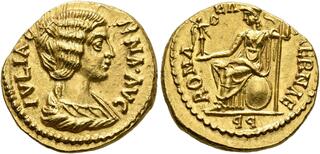| Leu Numismatik AG > Auction 15 | Auction date: 1 June 2024 |
| Lot number: 279 Price realized: This lot is for sale in an upcoming auction - Bid on this lot  | Show similar lots on CoinArchives Find similar lots in upcoming auctions on |
| Lot description: Julia Domna, Augusta, 193-217. Aureus (Gold, 20 mm, 7.07 g, 1 h), Alexandria, 194-195. IVLIA•D[O]-MNA•AVG Draped bust of Julia Domna to right. Rev. ROMΛ-E Λ-[E]TERNΛE / ꟼ ꟼ Roma seated left, holding Victory in her right hand and long scepter in her left; at her side, shield. R. F. Bland, A. M. Burnett and S. Bendall: The Mints of Pescennius Niger in the Light of Some New Aurei, in: NC 1987, p. 75-6 and pl. 11, 3-4 (same dies). BMC 333 and pl. 15, 4 (same dies) = Calicó 2636 = RIC 613 and pl. IX, 12. Of the highest rarity, apparently only the third known example. Struck slightly off center and with a few minor marks and faint scratches, otherwise, extremely fine. Ex Roma XXIX, 9 November 2023, 475. Although Alexandria was one of the great mints of the Roman Empire, Egypt's closed currency system meant that imperial money could not circulate in the province. Thus it was only on the rarest of occasions that the mint would produce imperial denominations, at least until Diocletian's reforms in 294. Curiously, shortly before his assassination, Commodus started producing denarii in Alexandria of lower average weight and fineness than those in Rome, an example followed by Pertinax and Septimius Severus, the latter after his victory over Pescennius Niger at Nicaea in 193. There can be little doubt that Severus' emissions were struck to pay his troops in the East, as they include the famed legionary types. While the denarii, though scarce, are frequently encountered, Severus also struck aurei at Alexandria, which are exceedingly rare, this apparently being the third Alexandrian aureus known for Julia Domna. Estimate: 7500 CHF |  |



